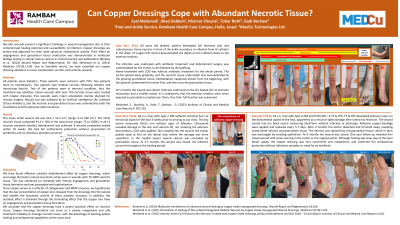Case Series/Study
(CS-103) Can Copper Dressings Cope with Abundant Necrotic Tissue?

Methods:
All patients were diabetics. Three patients were ischemic with PVD. Two patients were on hemodialysis. Two patients had residual necrosis following cellulitis and necrotizing fasciitis. Two of the patients were in terminal condition, thus the treatment was palliative. Eleven wounds with over 75% necrotic tissue were treated with copper dressings. Five wounds were major amputation stumps planned for revision surgery. Wound size was analyzed by an artificial intelligence (AI) software, and the necrotic and granulation tissue was estimated by both the AI software and the physician determinations.
Results: The mean initial wound size was 42.6 ± 52.2 cm2 (range: 9 to 180 cm2). The initial necrotic tissue composed 91.4 ± 10% of the wound size (range: 75 to 100%). In all 11 wounds complete autolytic debridement was achieved. 8 wounds completely healed within 10 weeks. We had full antibacterial protection without prescription of antibiotics and no infectious episodes occurred.
Discussion:
We have found effective autolytic debridement effect by copper dressings, which encourage the body's natural enzymatic action even in wounds with 70-100% necrotic tissue. This was combined (or initiated) with intense angiogenesis and granulation tissue formation and was proceeded with epithelization.
Since copper serves as a cofactor of collagenases and MMP enzymes, we hypothesize that the low concentration of copper ions released from the dressings into the wound bed amplify the enzymatic activity of these autolytic enzymes. In addition, the autolytic effect is achieved through the stimulating effect that the copper ions have on angiogenesis and granulation tissue formation.
We conclude that the copper dressings have a potent autolytic effect on necrotic tissue. Copper dressings therefore can serve as a simple, inexpensive and safe treatment modality to manage necrotic tissue, with the advantage of exerting potent healing and antibacterial capabilities at the same time.
Trademarked Items:
References: Borkow et al. (2010) Molecular mechanisms of enhanced wound healing by copper oxide impregnated dressings. Wound Repair and Regeneration 18:266.
Melamed et al. (2021) Stimulation of Healing of Non-Infected Stagnated Diabetic Wounds by Copper Oxide-Impregnated Wound Dressings. Medicina 57(10):1129.

.png)